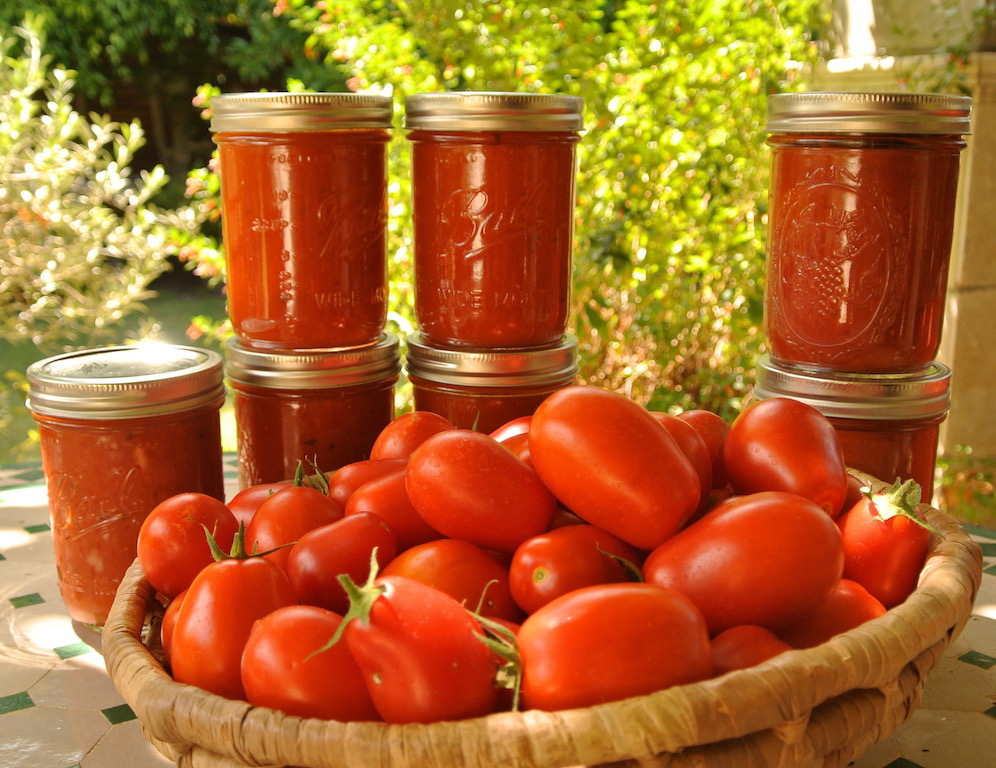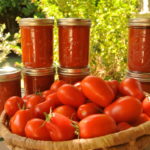
You know that old Star Trek episode where Captain Kirk is buried up his neck in Tribbles? That’s what I feel like right now because my tomato plants are producing baskets and baskets of Roma and San Marzano tomato every day.
Urban gardening in Los Angeles has turned out to be pretty easy. Driven by the drought of last year, I ripped out my front lawn and put in raised planter beds with a drip system. I planted kale, Swiss chard, lettuce greens and fava beans over the winter. As soon as I could put my hands on tomato starts, I got them in the ground.
In Los Angeles, tomato plants can keep producing well into October. I found the biggest challenge with raised bed planting is “tomato end rot”. Tomatoes love calcium so you need to be constantly feeding them with a good organic fertilizer. I put down a lot of calcium too using products found at garden stores made from ground oyster shells.
Now comes the question – what to do with all these tomatoes? For this, I took a page my Aunt Jennie who was a world-class canner. At first canning tomatoes seems like a daunting task but if you’re going for a simple strained sauce (a.k.a Marinara), it’s pretty easy.
So here’s how to do it. You’re going to need a good quantity of Ball jars (I use wide mouth 1-pint size), a canning lifter and a “food mill” with a small holed disk.
This recipe will produce the perfect base to use with dishes later in the year. Keeping this simple with minimal salt and other seasonings allows you to be creative with the sauce in dishes. Also, I’m not going to even attempt at state quantities here. This all about how many tomatoes you can get your hands on!
Print
Homemade canned tomato sauce
Ingredients
- One or more yellow onion, diced
- 6 or so cloves of garlic, peeled, crushed and rough chopped
- Extra virgin olive oil
- Washed and stemmed fresh Roma or San Marzano tomatoes
- Several big sprigs of basil, leaves removed from stems and discard stems
- 5 or 10 sprigs of thyme
Instructions
- In a large heavy bottom pot big enough to hold the tomatoes, place on medium heat and drizzle in several teaspoons of extra virgin olive oil. Let the oil warm and then add the onions. Sprinkle a little salt on the onions and then cover to let them “sweat”. Stir occasionally.
- After the onions have softened, add the garlic and let it slightly brown.
- Add all the tomatoes to the pot (you can chop them up before you put them, but there’s really no need)
- Add the basil and thyme.
- Give the whole pot a big tumbling toss with a wooden spoon and cover. The tomatoes with start to breakdown immediately and should be completely broken down in about 30 to 45 minutes. You can help the process along by smashing tomatoes to the side of the pot with a wooden spoon.
- Let the mixture cool somewhat so it’s easier to handle. Pick out the thyme stems but don’t worry if you miss some, you’ll catch them in the food mill.
- Set up a food mill over another pot and ladle in the cooked tomatoes. Starting cranking the food mill to get all the moisture out so you are just left with skins and seeds. Scrape off the pulp from the bottom of the food mill into the pot. Repeat until you’ve milled all the tomatoes.
- Now sterilize the Ball jars and lids. You can do this either by running them through your dishwasher with very little soap or in a big pot of boiling water. Be careful not to touch the inside of the jars or lids at this point.
- Using a measuring cup or ladle fill each jar to about a ½-inch below the rim with tomato sauce. Put the rubber ringed lid on the jar and the lightly screw the ring lid on – don’t tighten it.
- Now place the jars in another heavy bottom pot (depending on the number of jars, you may have to do this in batches. Add water around the jar until it reaches about middle of the ring lid.
- Now this is the part when you should be very careful. You can easily burn yourself. Bring the water to a boil. Once it boils, “process” the sauce for 30 minutes (you might have to add more water along if the water level lowers.
- Using a canning lifter, remove the jars to a tray. In less then a minute, you should hear the lids “pop” as the vacuum in the jar is formed. You’ll know this worked when divot in the center rubber ringed inverts downward. If after 5 minutes, you don’t hear the “pop”, let the jars cool to the point you can handle them and remove the rubber rimmed lid. Make sure there is a 1/2-inch of space between the liquid and the rim and clean the jar rim and rubber rimmed lid to remove any sauce. Reseal and re-process for 30 minutes.
- Tighten the ring lid. Let the jars cool completely and store away in your cabinet or pantry for future use.
Notes
Special equipment:
- Ball jars (I use wide mouth 1-pint size)
- Canning lifter
- “Food mill” with a small holed disk

Gorgeous – as all your recipes are! Tante grazie
Thanks very much!! Joe
I love homemade tomato juice! Thank you fro this recipe!
Thanks very much!! If you make homemade tomato juice, send pics!! Joe
Love your recipe. Just checking – all the notes I see online to can tomato sauce says to add lemon juice and salt. I don’t want to ruin the flavor of your sauce by doing this. So tell me, you can just can this sauce without doing that and it works?
Christine: Thanks for your comment!! I have seen some recipes that suggest this too but many that don’t. I canned about 3 dozens jars from this summer’s tomatoes with no lemon juice and they are keeping just fine. The main thing I’ve read that you can only can in a water bath if it for high acid foods like tomatoes, most summer fruits, etc. Otherwise you need a press-canner for stock, green veggies, etc. Hope that helps. Joe
Can I freeze this sauce? With the pandemic I’m having trouble finding supplies for canning!
Beth: You can definitely freeze sauce. I would suggest letting the sauce cool and placing in zip-lock bags. Press as much air out as possible and stand them up in case you don’t get a complete seal. You can freeze in other containers too. Glass containers theoretically are at risk of cracking as the liquid freezes but I’ve never seen it happen. Thanks! Joe
Hi Joe, we make this every year (quantities vary depending on how many tomatoes our garden produces) and freeze it in plastic containers (the containers that we puchase from a catering store are like the old fashioned plastic takeway containers that many Chinese restaurants used to use). Works a treat. We have just finished saucing this Summer’s crop (we are in Australia) and have ended up with 18 x 800 ml plastic containers and another 6 x 500mil containers full. We added basil to half of them as the basil has taken over the garden.